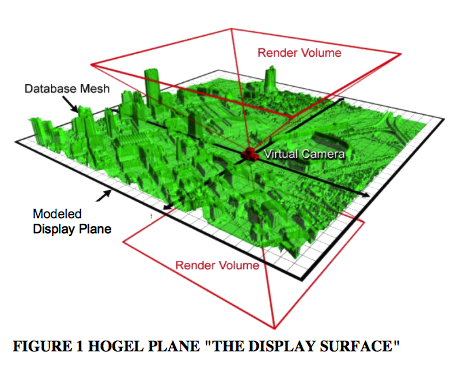 Zebra imaging rendered light field display model at SID 15
Zebra imaging rendered light field display model at SID 15
Zebra Imaging shows ZScape
Another 3D technology (OK this was a Holographic Lightfield Display) found in the IZone prototype booth at Display Week 15 was from a company called Zebra Imaging with its ZScape Motion Display for visitation and simulation awareness. The group was clearly targeting military applications and boasts dynamic and interactive images from diverse data sources, including LIDAR, CAD, Biometric, and Bathymetric (Ocean topography) all in real time.
This is a self-contained, real-time spatial 3D generator comprised of an array of holographic elements, the company calls ‘hogels’. Hogels in a lightfield display consist of emitted light that is controlled using both amplitude and color as a function of its direction. The company said to compute (render) a hogel it uses a 3D scene and a modeled display plane (for visualization).
“The display plane is modeled as a 2D array of micro lenses that correspond to camera positions on the display surface, defining a mathematical model of the physical emission surface of the display in model space. Hogels are computed at the center of every micro lens from the perspective of the holographic display plane. 3D operations such as pan, scale, zoom, tilt and rotate are accomplished by transforming the modeled display plane through the scene’s model space. Thus, the modeled display plane becomes a window into the 3D scene which translates to the projected 3D light-field visualization”, the company disclosed in the IZone application they filed with the SID.
One advantage is the full color image, and “all the qualities of a real physical object”, according to the company. It also emphasized that the technology is auto-viewable, there is no need for any special eyewear, head tracking or any other “cumbersome interface”. It’s also fully compatible with a broad range of front-end software applications and interactivity peripherals. Interactivity is directed by the front-end software application, and can interface with off the shelf 3D tracked wands and gloves, multi-touch, and video-game-like pointers.

